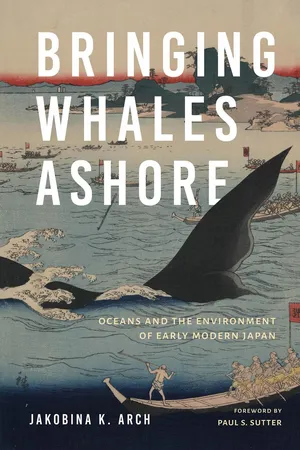![]()
NOTES
INTRODUCTION
1 For example, Jiji, “Endangered Gray Whale Spotted in Aichi Bay.”
2 International Court of Justice, “Whaling in the Antarctic.”
3 Given changing attitudes toward whaling internationally since the implementation of the moratorium, it is unlikely that a review will lead to it being lifted at this point. For more on the contemporary politics of whaling that led to the moratorium, see Dorsey, Whales and Nations.
4 Summit of Japanese Traditional Whaling Communities and Nihon Kujirarui Kenkyūjo, Report and Proceedings, 5.
5 Ibid., 7. This is a message Komatsu repeats in many of his publications about Japanese whaling.
6 Hobsbawm and Ranger, The Invention of Tradition. For more detailed discussion of the relevance of this concept of invented tradition in modern Japan, see Vlastos, Mirror of Modernity. For the whaling controversy in particular, see Arch, “Whale Meat in Early Postwar Japan.”
7 Two Japanese sociologists have written texts now available in translation counteracting the prowhaling argument that focus mostly on the modern whaling industry: Morikawa, Whaling in Japan, and Watanabe, Japan’s Whaling. Apart from these books, most of the English-language scholarship with any detail of Tokugawa period whaling is by anthropologist and whaling supporter Arne Kalland: Kalland and Moeran, Japanese Whaling: End of an Era?; Kalland, Fishing Villages in Tokugawa Japan. The issue of historical whaling also comes up in Jessamyn Abel, “The Ambivalence of Whaling,” and Nicol, Taiji—Winds of Change. Frank Hawley attempted to write a comprehensive history of Japanese whaling based on his experience with modern whalers in Japan, but never completed more than the first volume: Hawley, Whales and Whaling in Japan.
8 Kalland and Moeran, Japanese Whaling; Abel, “The Ambivalence of Whaling”; Nicol, Taiji—Winds of Change. Hawley, Whales and Whaling in Japan.
9 Some examples of his publications include Komatsu, Kujira sono rekishi to bunka; Yoku wakaru kujira ronsō; Kujira to Nihonjin; Rekishi to bunka tanbō. His Kujira to sanpo, 102–8 even has six pages listing places where one can buy whale meat today. See also Normile, “Japan’s Scientific Whaling.”
10 For example, in both Komatsu, Kujira sono rekishi to bunka and Yoku wakaru kujira ronsō, he begins with evidence that the people of the Jōmon period hunted whales in some fashion, even though this was at least two thousand years before the appearance of organized whaling groups in Japan and there is no evidence of a continuous whaling practice in the intervening time. See also Takahashi, Kujira no Nihon bunkashi.
11 Yamase, Geishi.
12 In comparison, American whaling ships from the nineteenth century had crews of about thirty-five men each and usually operated as independent units. Numbers are hard to find for factory ship whaling, but one report noted a crew of three hundred men on a single factory ship—it is unclear whether that included the twelve- to sixteen-person crew on each of the half-dozen or so catcher or killer boats that accompanied the factory ships. Walsh and Capelotti, Whaling Expedition of the Ulysses.
13 Ibid., 14.
14 For example, the series of books by former chief of the Japanese Fisheries Agency Komatsu Masayuki. Examples include Yoku wakaru kujira ronsō; Kujira sono rekishi to bunka; Rekishi to bunka tanbō.
15 Morikawa, Whaling in Japan, 20.
16 Nishiwaki, “Failure of Past Regulations and the Future of Whaling,” 45. This comment was repeated in a much more recent work, so it has a lingering negative influence on our image of Tokugawa whaling; Abel, “The Ambivalence of Whaling,” 323.
17 Taiji whalers caught ninety-five whales in 1681. Kondō, Nihon engan hogei no kōbō, 33. Arikawa whalers caught eighty in 1695. Sueta, “Kinsei Nihon ni okeru hogei,” 439. They were far from the only groups operating in either the Kumano area or the Saikai area of Kyushu at the time.
18 While we have no census of whale populations before this point, the population clearly had to be larger than the total taken in this decade, especially since whales only give birth to one offspring every two years on average. Reilly et al., “Eubalaena japonica.”
19 Ellis, Men and Whales.
20 Arch, “From Meat to Machine Oil.”
21 Watanabe, Japan’s Whaling.
22 Statistics Bureau of Japan, “Chapter 5: Agriculture, Forestry, and Fisheries;” Statistics Bureau of Japan, “Chapter 7: Agriculture, Forestry, and Fisheries,” under “39 Households, Household Members and Persons Engaged in Marine Fisheries (1953–2003).”
23 Nippon Suisan Kaisha, “A History of Hundred Years of Nippon Suisan Kaisha, Ltd.,” www.nissui.co.jp/english/corporate/100yearsbook/pdf/100yearsbook.pdf. 20.
24 The Institute for Cetacean Research (ICR) had “over fifty employees” in 2004. Morikawa, Whaling in Japan, 41. The 170 crew members who operate the ships and kill whales under IWC “scientific” whaling permits come from Kyōdō Senpaku, which also employs twenty-eight people on shore. This company is the privately held remains of the last commercial whaling companies in Japan, and performs whaling operations under charter to the government subsidized nonprofit ICR: Kaisha gaiyō, www.kyodo-senpaku.co.jp/corporate.html#link_02. The International Court of Justice ruled in 2014 that the supposedly scientific permits that Japan issued to allow the ICR with the cooperation of Kyōdō Senpaku to hunt whales in Antarctica were not actually for the purposes of scientific research, and thus should not fall under the scientific exemption allowed by the International Whaling Commission to their 1986 commercial moratorium on whaling. For details on the court decision, see International Court of Justice, “Whaling in the Antarctic” and the summary of the judgment at www.icj-cij.org/docket/files/148/18160.pdf.
25 There are still a few coastal whaling groups operating, but they generally focus on smaller species like dolphins, with the exception of the few beaked whales still caught on the Bōsō Peninsula.
26 In 1993 Amino discussed increasing interest in considering the ocean’s relationship to Japan. Clear examples of how Amino viewed Japanese history from a marine as well as terrestrial perspective can be seen in Amino, Umi to rettō no chūsei and Umi kara mita Nihon shizō. For one of the major exceptions to the marginalization of the oceans in premodern Japanese history, see ...
